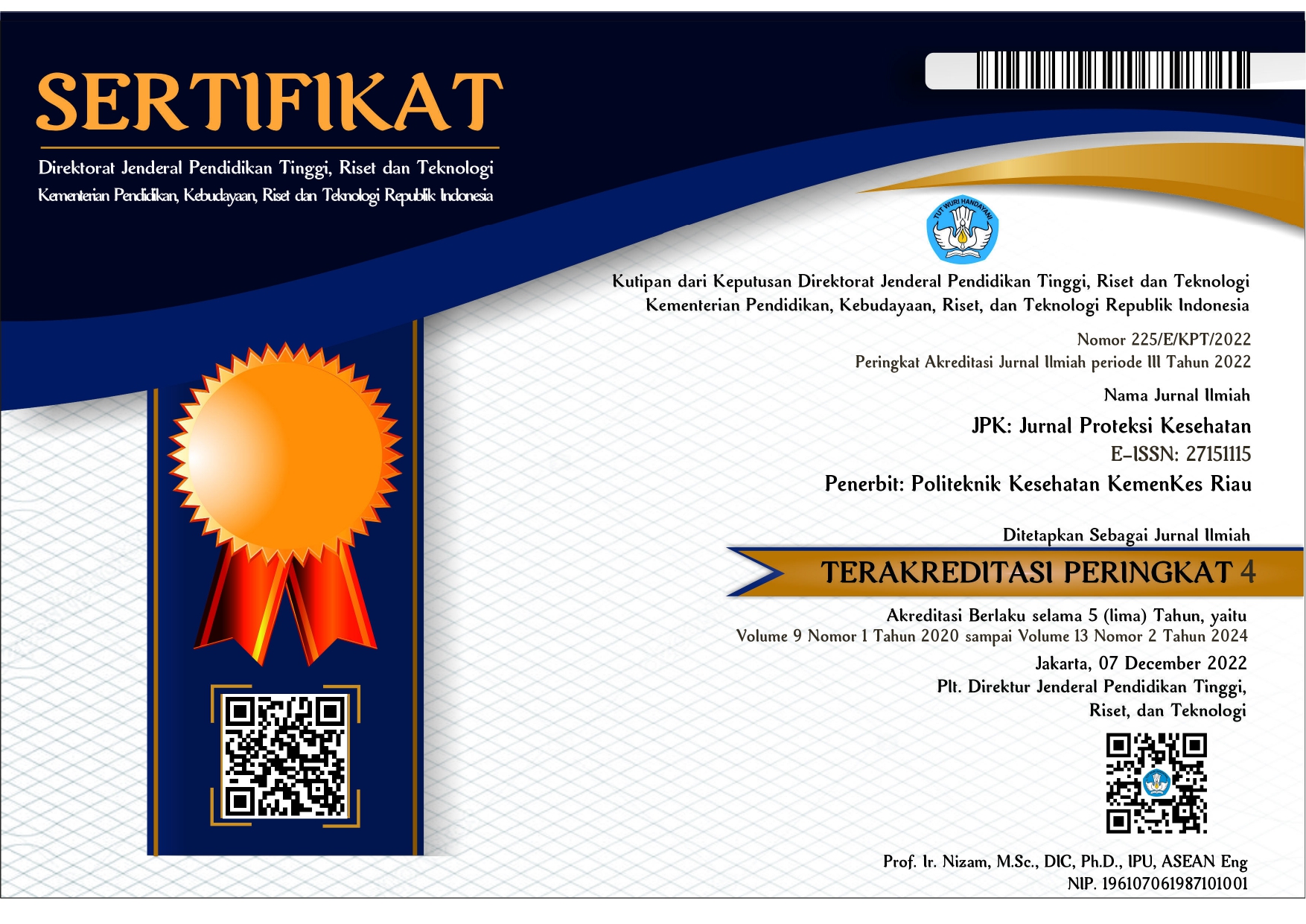Literature Review: Ice Cube Therapy to Reduce Thirst in Patients Undergoing Hemodialysis
Abstract
Chronic kidney failure is a malfunction of the kidneys which occurs over a relatively long period of time, this is the cause of reduced individual ability to maintain metabolism, fluid balance in the body which will then cause high urea values. Hemodialysis (HD) is an attempt to replace kidney function in filtering metabolic wastes, water and maintaining electrolyte levels in the body through a semi-shift membrane called Dalizer. . Ice Cubes therapy can help reduce thirst and freshen the throat. Ice cubes therapy is done by sucking ice cubes, where ice cubes can give a fresher feeling than drinking small amounts of mineral water, gargling with boiled water, gargling with medicines and others. To identify the effect of ice cube's on efforts to reduce thirst in patients undergoing hemodialysis. Data collection used the literature review study method using the Ebsco, Google Schooler, and Elsevier databases. With keywords: Ice Cube's Therapy, Hemodialysis Patients, Thirst with limited articles from 2018-2023. Obtained from 10 articles with 148 respondents in the Pretest Posttest research design and 4 respondents with a case study research design showing that there was an effect of ice cube's therapy on decreasing thirst in CKD patients undergoing Hemodialysis. In this literature review, it was found that there was an effect of ice cube's therapy on reducing thirst in CKD patients who were undergoing hemodialysis.
References
[2] U. Najikhah and W. Warsono, “Penurunan Rasa Haus Pada Pasien Chronic Kidney Disease (CKD) Dengan Berkumur Air Matang,” Ners Muda, vol. 1, no. 2, p. 108, 2020, doi: 10.26714/nm.v1i2.5655.
[3] I. Fatoni and D. Hudiyawati, “Aplikasi Menghisap Es Batu Terhadap Intensitas Rasa Haus Pada Pasien Yang Menjalani Hemodialisa Di Rumah Sakit Pku ‘ Aisyiyah Boyolali,” vol. 9, pp. 17–18, 2019.
[4] Y. Armiyati, K. Khoiriyah, and A. Mustofa, “Optimization of Thirst Management on CKD Patients Undergoing Hemodialysis by Sipping Ice Cube,” Media Keperawatan Indones., vol. 2, no. 1, p. 38, 2019, doi: 10.26714/mki.2.1.2019.38-48.
[5] WHO, “Chronic kidney disease,” Lancet, vol. 398, no. 10302, pp. 786–802, 2021, doi: 10.1016/S0140-6736(21)00519-5.
[6] Kemenkes RI, “Hasil Riset Kesehatan Dasar Tahun 2021,” Kementrian Kesehat. RI, vol. 53, no. 9, pp. 1689–1699, 2021.
[7] C. Abbafati et al., “Global burden of 369 diseases and injuries in 204 countries and territories, 1990–2019: a systematic analysis for the Global Burden of Disease Study 2019,” Lancet, vol. 396, no. 10258, pp. 1204–1222, 2020, doi: 10.1016/S0140-6736(20)30925-9.
[8] Kemenkes RI, Profil Kesehatan Indonesia 2021. 2022.
[9] C. J. . Murray and A. D. Lopez, “Global Burden of Disease and Injur Y Series the Global Burden of Disease,” Oms, pp. 1–46, 2020, [Online]. Available: https://apps.who.int/iris/handle/10665/41864.
[10] PERNEFRI, “11th report Of Indonesian renal registry 2018,” Indones. Ren. Regist., pp. 14–15, 2018.
[11] Kemenkes RI, “RISKESDAS 2020.” 2020.
[12] Guyton, Textbook of Medical Physiology. 2018.
[13] G. G. Sacrias and E. L. Rathinasamy, “Effect of nursing interventions on thirst and interdialytic weight gain of patients with chronic kidney disease subjected to hemodialysis,” Brunei Darussalam J. Heal., vol. 6, no. 1, pp. 13–19, 2015.
[14] A. N. Fajri, Sulastri, and P. Kristini, “Pengaruh Terapi Ice Cube ’ S Sebagai Evidance Based Nursing Untuk Mengurangi Rasa Haus Pada Pasien,” Pros. Semin. Nas. Keperawatan Univ. Muhammadiyah Surakarta, vol. 1, no. 3, pp. 11–15, 2020, [Online]. Available: GGK, Rasa Haus,%0ATerapi Ice Cube’s.
[15] M. Rosaulina, Z. Zuliawati, and C. Indrayani, “Pengaruh Terapi Ice Cubes Terhadap Penurunan Rasa Haus Pada Pasien Gagal Ginjal Kronik Yang Menjalani Hemodialisa Di Rsu Sembiring,” J. Penelit. Keperawatan Med., vol. 4, no. 1, pp. 17–23, 2021, doi: 10.36656/jpkm.v4i1.670.
[16] W. A. C. Ningrum, Imardiani, and S. Rahma, “Faktor yang berhubungan dengan kualitas tidur pasien gagal ginjal kronik dengan terapi hemodialisa,” Semin. dan Work. Nas. Keperawatan “Implikasi Perawatan Paliat. pada Bid. Kesehatan,” pp. 279–285, 2017.
[17] P. F. Wiliyanarti and A. Muhith, “Life Experience of Chronic Kidney Diseases Undergoing Hemodialysis Therapy,” NurseLine J., vol. 4, no. 1, p. 54, 2019, doi: 10.19184/nlj.v4i1.9701.
[18] D. Basuki, “Pengaruh Menghisap Slimber Ice Terhadap Intensitas Rasa Haus pasien Gagal Ginjal Kronik Yang Menjalani Hemodialisa,” Indones. J. Heal. Sci., vol. 2, no. 2, pp. 77–83, 2018.
[19] E. L. Nurhayati, “The Effectiveness of Chewing Gum and Sucking Ice Cubes in Reducing Thirst in Chronic Kidney Failure Patients Undergoing Hemodialysis,” Int. J. Med. Sci. Clin. Res. Stud., vol. 02, no. 07, pp. 659–664, 2022, doi: 10.47191/ijmscrs/v2-i7-12.
[20] N. W. Heriansyah, Aji Humaedi, “Gambaran Ureum Dan Kreatinin Pada Pasien Gagal Ginjal Kronis Di Rsud Karawang,” Binawan Student J., vol. 01, no. 01, pp. 8–14, 2019.
[21] R. Dewi and A. Mustofa, “Penurunan Intensitas Rasa Haus Pasien Penyakit Ginjal Kronik Yang Menjalani Hemodialisa Dengan Menghisap Es Batu,” Ners Muda, vol. 2, no. 2, p. 17, 2021, doi: 10.26714/nm.v2i2.7154.
[22] E. S. Pius and S. Herlina, “Faktor-Faktor Yang Berhubungan Dengan Kualitas Tidur Pada Pasien Gagal Ginjal Kronik Yang Menjalani Hemodialisis Di Rumah Sakit Tarakan Jakarta,” J. Keperawatan Widya Gantari Indones., vol. 3, no. 1, 2019, doi: 10.52020/jkwgi.v3i1.1081.
[23] D. P. Lestari and E. Hidayati, “Slimber Ice Efektif Menurunkan Rasa Haus pada Pasien Gagal Ginjal Kronik yang Menjalani Hemodialilisa di Khorfakkan Hospital Uni Emirate Arab,” no. 2, 2022.
[24] I. Isrofah, M. P. Angkasa, and A. A. Ma’ruf, “The Efffect Of Sipping Ice To Reducethirsty Feel In Chronic Kidney Disease Patients Who Have Hemodialysis In Rsud Bendan Pekalongan City,” Int. Nurs. Conf. Chronic Dis. Manag., pp. 193–197, 2019, [Online]. Available: https://proceeding.unikal.ac.id/index.php/Nursing/article/view/207












